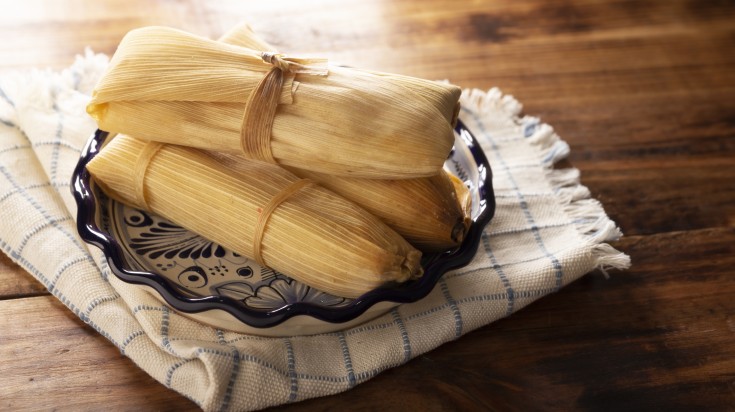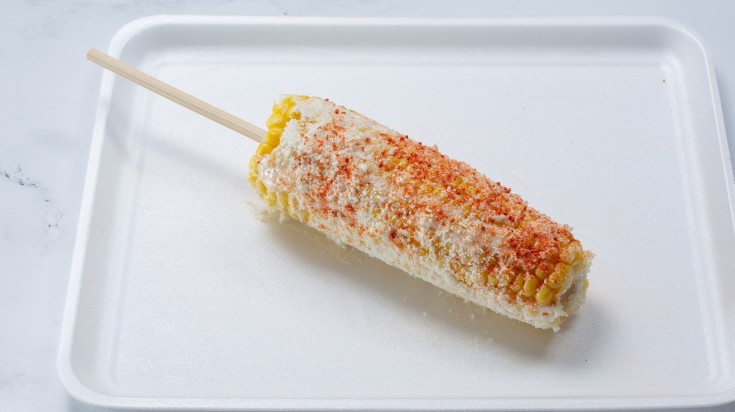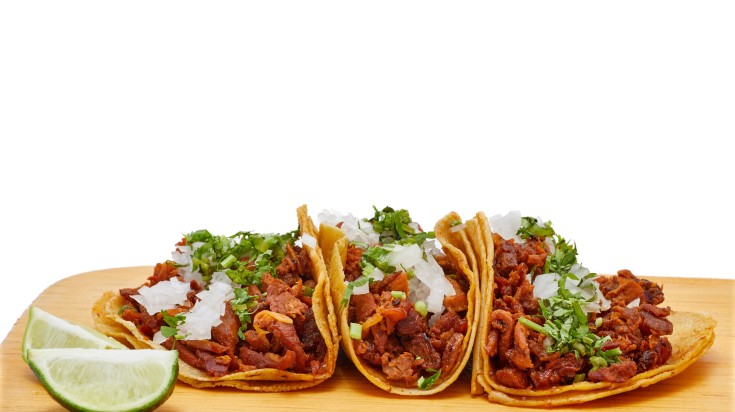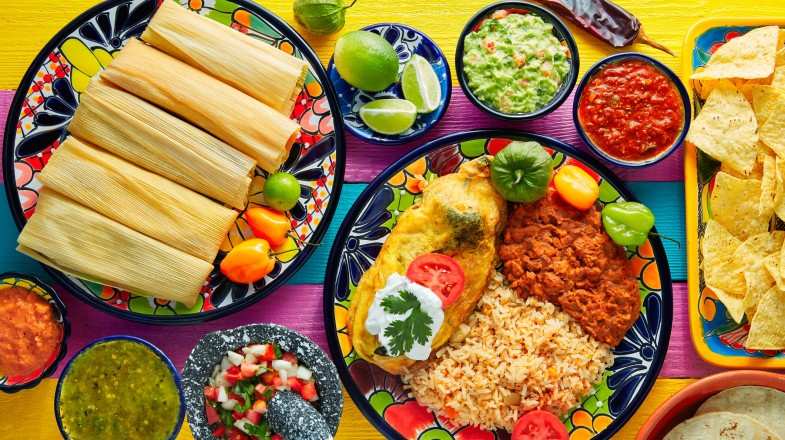Top 10 Traditional Mexican Foods to Try While in Mexico
From the sizzle of streetside tacos to the warmth of homemade tamales, Mexico’s traditional culinary landscape is a tapestry of flavors and colors passed down through generations. Authentic Mexican taste stands in a league of its own, far removed from what you'd typically find in fast food chains anywhere else in the world. Whether you're a Mexican cuisine fanatic or have yet to try it, a trip to Mexico to savor its traditional food offerings promises an exciting culinary experience.
Let’s look at the top 10 best traditional Mexican foods that are a must-try while you explore the diverse regions of Mexico.
- Georgina Lowe
- From England
1. Enmolada

Say what: en-mo-la-dah
The enmolada blends indigenous ingredients with the culinary influences of Spain, creating an authentic Mexican treasure. Enmoladas feature corn tortillas filled with various delectable ingredients, such as shredded chicken, beef, or beans, and coated in a velvety, aromatic mole sauce. The tortilla is garnished with a sprinkle of sesame seeds and perhaps a dollop of Mexican crema, offering a touch of creaminess to balance the rich, spicy sauce.
Enmoladas are mostly feasted upon as a staple snack during celebratory occasions, family gatherings, and holidays, making it an integral component of Mexican culture.
Tip: If you have a low tolerance for spicy food, request less mole sauce and a bit more Mexican crema or other toppings for a milder flavor profile.
2. Mole

Say what: moh-lay
Mole is a rich and complex sauce renowned for its intricate flavors, originating in pre-Hispanic Mexico. While each region boasts unique recipes and styles, the main ingredients include chilies, spices, chocolate, and sometimes nuts.
Mole is a staple in Mexican culture, particularly during festive occasions and family gatherings. It frequently accompanies traditional dishes like tamales, enmoladas, and chicken, enhancing their flavors with its savory and spicy profile.
Tip: The rich mole sauce is known for its complexity, and you’ll discover a delightful harmony of flavors with each bite. Don’t hesitate to embrace the heat, but if you have a significant spice intolerance, ask for less spice when placing an order. Remember that some restaurants may not accommodate customizations as mole is often prepared in large batches.
3. Tamales

Say what: ta-mah-lays
Tamale, a cornerstone of traditional Mexican cuisine, has a rich history that spans centuries, tracing back to the ancient Aztec and Maya civilizations. This classic breakfast food consists of masa, a dough made from finely ground corn seasoned with various ingredients like spices, chilies, and sometimes lard for a rich, flavorful base. Wrapped in either corn husk or banana leaf, this dough is steamed and can feature a variety of fillings, including meats, cheese, vegetables, or sweet options like chocolate or fruit.
Traditionally, tamales are enjoyed for breakfast and during special occasions and holidays, such as Christmas, the Day of the Dead, or weddings, as they bring people together to celebrate culture and cuisine.
Tip: Eat tamales with a side of salsa or a drizzle of hot sauce to elevate their flavors. Each region in Mexico has its own unique tamale recipes, so explore regional variations.
4. Bacalao Navideño

Say what: ba-ka-lay-o na-vi-den-yo
Bacalao Navideño, also known as ‘Christmas Cod,’ is a fish stew traditionally eaten during Christmas Eve (Nochebuena) or New Year’s Eve (Nochevieja) feasts, along with sides such as ensalada Navideña de coditos.
Bacalao Navideño is centered around salted codfish, a staple ingredient in many Spanish and Mexican dishes due to its long shelf life. The codfish is rehydrated and desalinated through soaking, then flaked into tender pieces. It’s carefully simmered in a rich tomato-based sauce, typically enhanced with ingredients like olives, capers, onions, and garlic, offering a delightful medley of flavors and textures.
Tip: Preparing bacalao Navideño takes time, especially due to the desalination process of the cod fish. So, you do not want to request freshly caught cod fish at restaurants as you would for other fish dishes.
5. Arroz Rojo (Mexican Red Rice)

Say what: ah-roz ro-yah
Arroz rojo, or Mexican red rice, is an essential component of traditional Mexican cuisine, often accompanying many traditional Mexican dishes like tamales, enchiladas, tacos, and spicy stews. It’s an integral part of Mexican culture, often appearing at family gatherings, fiestas, and daily meals. This dish centers around white rice, sautéed with finely chopped onions and garlic until it turns a beautiful golden hue. What sets arroz rojo apart is the addition of fresh tomatoes or tomato sauce or paste, which gives the rice its distinctive red color and a burst of rich, tomatoey flavor. It’s often simmered with spices like cumin and bay leaves to enhance the taste.
Tip: Search for family-run restaurants while on your Mexico City tour to taste the most authentic arroz rojo.
6. Enchiladas

Say what: en-chi-la-dah
The essence of authentic Mexican flavor and culture is encapsulated in an enchilada. These mouthwatering creations trace their history back to the ancient Aztecs and Mayans, who wrapped tortillas around other foods, often filled with chili peppers, making them an enduring symbol of Mexican culinary heritage.
Enchiladas typically feature corn tortillas rolled around a variety of fillings, such as meat, cheese, beans, or vegetables, which are then generously topped with shredded cheese, diced onions, and a dollop of sour cream before being baked to perfection, resulting in a bubbling and irresistible dish. What distinguishes enchiladas from enmoladas is the signature sauce — enchiladas are generously coated in a vibrant chili sauce, which can range from fiery red, often using guajillo peppers, to milder green, often made with tomatillos, in contrast to the mole sauce that tops an enmolada.
Eaten throughout Mexico, enchiladas are a versatile dish enjoyed for breakfast, lunch, or dinner. They often accompany rice and beans, creating a wholesome and satisfying meal.
Good to know: Lightly frying the tortillas for enchiladas before rolling them enhances their flavor and texture, making them even more delectable.
7. Elote

Say what: ee-loh-tay
Elote, often referred to as Mexican street corn, consists of freshly grilled or boiled ears of corn slathered in a luscious mixture of mayonnaise, crema (a Mexican sour cream), crumbled cotija cheese, chili powder, and a squeeze of lime juice. The result is a delightful combination of creamy, tangy, and spicy flavors that coat the sweet, tender corn.
This dish’s roots can be traced back to pre-Columbian times when indigenous peoples in Mexico cultivated and consumed corn as a staple. Elote evolved over centuries, influenced by Spanish colonial flavors and techniques. Today, it’s commonly enjoyed throughout Mexico and by Mexican communities worldwide.
Traditionally, elote is a popular street food, often found at food carts and stalls, making it a convenient and accessible snack. It’s frequently eaten during festivals, fairs, and outdoor gatherings, adding to the lively atmosphere.
Tip: Consider using wooden sticks or holders to keep your hands clean and avoid the deliciously messy experience that comes with savoring this traditional Mexican delight.
8. Tacos al Pastor

Say what: ta-kowz al pas-tor
No food tour in Mexico is complete without tasting the world-famous tacos. Tacos al pastor are a tribute to Mexican immigrants of Lebanese and Middle Eastern descent who arrived in the early 1900s. These iconic tacos feature thinly sliced marinated pork imbued with spices like achiote, cumin, and garlic, offering a reddish hue and a fragrant taste. The meat is meticulously stacked on a vertical rotisserie, akin to the shawarma or gyros cooking method. As it slowly roasts, the outer layer is carved off and nestled within soft corn tortillas, adorned with toppings such as finely chopped onions, fresh cilantro, pineapple chunks, and zesty salsa.
Tacos al pastor are relished across Mexico, particularly in urban locales, where taquerias and street vendors abound. These healthy treats are often indulged in late at night, making them a favored midnight snack post-night out.
Tip: Try different salsas with your tacos al pastor. Each region and taqueria may have a special salsa recipe that uniquely complements the dish.
9. Chilaquiles

Say what: chee-lah-kee-lays
Chilaquiles are a beloved breakfast dish that combines crispy tortilla chips, typically made from stale tortillas, with a rich and spicy red salsa (tomato-based sauce) or a rich green salsa (tomatillo and chili pepper sauce). The chips soak up the sauce, rendering them slightly softened while still retaining some crunch. Chopped onions, fresh cilantro, crumbled queso fresco, and a dollop of crema add layers of flavor and texture. Shredded chicken or fried eggs often crown this dish, making it a hearty breakfast or brunch option.
Chilaquiles have a fascinating history rooted in Mexican culinary culture. They're believed to have ancient origins, tracing back to the Aztecs, who consumed a similar dish called tlaxcalli. Over time, this humble dish evolved into the chilaquiles we know today, embraced throughout Mexico and revered for its simplicity and bold flavors.
Tip: If you enjoy a fiery kick, ask for extra chili sauce or add some hot peppers. For a milder flavor, request a tamer salsa.
10. Chiles en Nogada

Say what: chee-lays en no-gah-dah
Chiles en nogada is a revered and iconic Mexican dish celebrated for its rich history and vibrant presentation. This traditional Mexican food is associated with Mexican independence and is commonly enjoyed on Independence Day in September. The green peppers, white walnut sauce, and red pomegranate seeds represent the colors of the Mexican flag.
This dish consists of poblano peppers, typically roasted and peeled to reveal their mild, smoky flavor. The peppers are then stuffed with picadillo, a delectable combination of ground meat (often beef or pork), fruits like apples and pears, nuts, and aromatic spices. The picadillo filling is a harmonious blend of sweet and savory flavors but what truly distinguishes chiles en nogada is the exquisite walnut-based cream sauce, nogada, which envelops the stuffed peppers. This creamy, slightly sweet sauce is adorned with pomegranate seeds, giving the dish a burst of color and a delightful crunch.
Tip: To fully savor chiles en nogada, pair it with a glass of chilled Mexican white wine or a classic agua de jamaica (hibiscus tea) to balance the rich flavors.
Traditional Mexican cuisine is a rich tapestry of flavors, blending indigenous ingredients with diverse influences from around the world. Each dish tells a story of history and culture, from tacos al pastor, with roots in Middle Eastern traditions, to the savory enchiladas and aromatic tamales. Whether savoring elote from a street vendor or indulging in mole’s complex flavors, you’re tasting the essence of Mexico’s vibrant food culture. These dishes are not just meals; they connect to centuries of tradition, enjoyed throughout Mexico, and celebrated worldwide.
Traveling to Mexico for your culinary adventure soon? Fill out our customized trip form for Mexico so you can curate your own experience.








